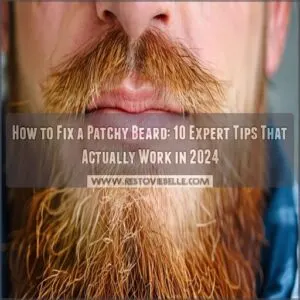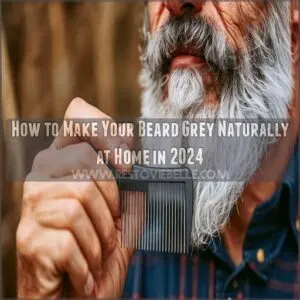This site is supported by our readers. We may earn a commission, at no cost to you, if you purchase through links.
 If you’re wondering how to fix a patchy beard, patience is your first ally.
If you’re wondering how to fix a patchy beard, patience is your first ally.
Let it grow for four to six weeks without trimming to reveal its true potential.
Meanwhile, focus on good grooming—use a boar bristle brush to train stubborn hairs and trim to create a fuller appearance.
Eating a balanced diet rich in protein, biotin, and omega-3s can work wonders, too.
Supplements like biotin or even minoxidil might give you an edge.
Embrace your unique beard style—after all, it’s not about perfection.
There’s more where that came from—explore styling secrets and growth strategies that work wonders.
Table Of Contents
- Key Takeaways
- Genetics and Hormonal Levels
- Identifying Causes of Patchy Beard
- Letting Your Beard Grow
- Beard Care and Styling Techniques
- Dietary Changes for Beard Growth
- Supplements and Vitamins for Beard Growth
- Medical Treatments for Patchy Beard
- Lifestyle Changes for a Fuller Beard
- Visual Solutions for a Patchy Beard
- Embracing Your Unique Beard
- Frequently Asked Questions (FAQs)
- Can you fix a patchy beard?
- How to fill in a patchy beard?
- Do you have a patchy beard?
- How do you style a patchy beard?
- What causes a patchy beard?
- Should I let my beard grow if it’s patchy?
- Do beard patches fill-in?
- Are patchy beards attractive?
- Can a patchy beard fill in?
- Can patchy beard be fixed by shaving?
- Is patchy beard because of low testosterone?
- Should I trim my beard if it’s patchy?
- How long does minoxidil take to work?
- Can beard fill-ins create a natural look?
- How to maintain a patchy beard daily?
- Are beard transplants a viable option?
- Do essential oils really help beard growth?
- Conclusion
Key Takeaways
- Let your beard grow for 4-6 weeks to assess its true potential before trimming.
- Use a boar bristle brush and strategic trimming to create a fuller appearance.
- Improve your diet by eating protein, biotin, and omega-3s to support hair growth.
- Consider supplements like biotin or minoxidil, or medical treatments like microneedling, to boost growth.
Genetics and Hormonal Levels
You can thank your parents for your beard’s patchiness, as genetics and inadequate levels of vitamin D for beard growth strongly influence how your facial hair grows.
Hormones, especially testosterone and DHT, also play a big part in determining your beard’s thickness and coverage, which is why you’ll notice better growth as you get older.
Role of Testosterone and DHT in Beard Growth
Think of testosterone and DHT as your beard’s best friends.
These hormones work together to transform those tiny facial hair follicles into a full beard.
Your body converts testosterone into DHT, which then signals your follicles to start growing thicker, darker hair.
To boost your DHT levels, consider taking a DHT Supplement.
When these hormone levels are low or your body isn’t converting them efficiently, you’ll likely notice patches in your beard growth.
How Genetics Affect Beard Growth
Just like your height and eye color, your beard’s growth pattern comes straight from your family tree.
Your genetic code influences several key factors, including your sensitivity to hormones like DHT and testosterone, which affect beard thickness and growth pattern.
Understanding these inherited traits helps you set realistic expectations and work with what nature gave you.
Impact of Unresponsive Androgen Receptors
Your beard growth doesn’t just depend on testosterone levels – those hormones need somewhere to land.
Androgen receptors are like docking stations for testosterone and DHT, and when they’re not responding well, your beard can end up patchy.
Low receptor sensitivity means even if you’ve got healthy hormone levels, they can’t properly stimulate your hair follicles. It’s like having a great fuel supply but a faulty engine.
Identifying Causes of Patchy Beard
You can’t fix your patchy beard until you know what’s causing the problem, whether it’s poor blood flow to your cheeks or lifestyle habits like missing sleep.
Understanding these root causes will help you choose the right solution, from changing your diet to adjusting your sleep schedule for better beard growth.
Poor Circulation in The Cheeks
Poor circulation can make growing a full beard feel like waiting for water to flow uphill.
Here’s how to boost blood flow to those stubborn cheek patches:
- Try a 5-minute facial massage each morning using circular motions
- Practice cheek exercises like puffing and stretching throughout the day
- Apply a warming beard oil with cinnamon or peppermint
- Keep skin exfoliated with a gentle scrub twice weekly
Lifestyle Factors Affecting Beard Growth
Lifestyle habits have a big impact on beard growth.
Beyond circulation issues, daily choices can make or break your facial hair game.
Here’s what’s affecting your beard behind the scenes:
| Factor | Impact | Quick Fix |
|---|---|---|
| Sleep Quality | Reduces DHT production | 7-8 hours nightly |
| Exercise | Boosts testosterone | 3-4 weekly sessions |
| Stress | Increases cortisol | Daily meditation |
| Alcohol | Lowers testosterone | Limit consumption |
| Screen Time | Disrupts sleep hormones | Night mode after 8pm |
Nutrition and Beard Growth
The food you put on your plate shapes how well your beard grows.
Think of your facial hair like a garden – it needs the right nutrients to thrive.
Loading up on protein-rich foods helps build stronger hair, while biotin, vitamin D, and zinc work behind the scenes to boost growth.
A diet rich in zinc-rich foods like oysters can support facial hair growth by promoting healthy follicles.
Iron keeps those follicles happy, so add some lean meats and leafy greens to your daily menu.
Stress and Sleep Impact on Hormone Production
When stress takes over your life, it throws your hormone levels into chaos, especially cortisol – the arch-nemesis of healthy beard growth.
Getting quality sleep helps balance these hormones naturally.
Here’s what happens when you’re stressed and sleep-deprived:
- Your body produces excess cortisol, blocking testosterone production
- Growth hormone levels drop during poor sleep cycles
- Your skin’s repair mechanisms slow down, affecting follicle health
Letting Your Beard Grow
You’ll need to resist the urge to trim your patchy beard for at least 4-6 weeks to see your true growth potential.
While waiting might feel like watching paint dry, this patience will give you the best picture of which areas need extra attention and care.
Allowing 4-6 Weeks for Full Growth Potential
Your beard’s growth journey takes time, so don’t jump to conclusions too quickly.
Consider using a beard growth serum to boost your progress.
Give it at least 4-6 weeks of uninterrupted growth to see its true potential – patches that seem empty now might surprise you.
During this waiting period, resist the urge to trim or shape.
Think of it like growing a garden; you need patience to see what sprouts.
This timeframe lets you properly assess your natural growth pattern.
Trimming and Shaving Strategies for Patchy Beards
Smart trimming can make a world of difference for patchy beards.
After letting it grow, focus on these game-changing techniques:
- Keep patchy areas shorter (1-2mm) while leaving fuller spots slightly longer to create balance
- Fade the neckline gradually instead of harsh lines to draw attention upward
- Use a precision trimmer to sculpt clean edges around your strongest growth patterns
Remember, you’re not trying to hide patches completely – you’re working with what you’ve got to create your signature look.
Beard Care and Styling Techniques
You can transform your patchy beard into a masterpiece with the right grooming tools and styling techniques.
A boar bristle brush, proper trimming methods, and smart styling choices will help you create the appearance of a fuller, more polished beard that’ll make heads turn.
Using Boar Bristle Brushes for Beard Direction
Using minoxidil products like Rogaine for beard growth can help transform vellus hairs into thicker terminal hairs, making your beard look fuller. A good boar bristle brush works wonders for training your beard hair.
The natural bristles help distribute oils evenly throughout your facial hair, preventing dry patches and promoting healthier growth.
Using a brush with high-quality first-cut boar bristles can make a big difference in achieving the desired results.
Start at the neckline and brush upward, then work your way down in the direction you want your beard to grow.
Regular brushing also stimulates blood flow to the follicles, making your beard look fuller.
Trimming and Shaping for Fuller Appearance
A mirror and the right trimming techniques can transform a patchy beard into a masterpiece.
Start by letting your beard grow slightly longer in fuller areas, then gradually fade into shorter lengths where growth is sparse.
Use sharp scissors to precisely shape the neckline and cheeks.
Regular maintenance with a quality trimmer helps create clean lines that draw attention away from patches.
Experimenting With Beard Styles for Patchy Areas
Everyone can rock a great beard style, even with patchy growth.
Try a classic goatee to highlight your chin’s fullness while minimizing sparse cheeks.
The Van Dyke style works wonders for patchy sides, while the Balbo beard cleverly draws attention to stronger growth areas.
Short stubble or a faded beard can mask uneven patches, making your facial hair look intentionally styled rather than sparse.
Dietary Changes for Beard Growth
According to experts, a balanced diet rich in proteins, vitamins, and minerals is key to promoting healthy hair growth. You might be surprised to learn that your diet plays a huge role in fixing your patchy beard and boosting hair growth.
By making smart food choices rich in protein, biotin, and omega-3s, you’ll give your facial hair the nutrients it needs to transform from sparse to spectacular.
Foods Rich in Protein, Biotin, and Omega-3 Fatty Acids
Beyond grooming, what you eat directly impacts beard fullness.
Load up your plate with protein powerhouses like eggs, lean meats, and fish – they’re the building blocks for stronger facial hair.
Foods packed with biotin (think nuts and legumes) help strengthen each strand, while omega-3 rich options like salmon and chia seeds reduce inflammation and support healthy follicles.
Consider it fuel for your facial forest.
Incorporating Beard Growth-Promoting Foods
Boosting your beard game starts in the kitchen.
Load up on sorghum, oysters, and olive oil – they’re packed with nutrients that support hair growth.
Add pomegranate juice and alfalfa sprouts to your smoothies, and don’t skip your morning coffee.
These power foods work together to stimulate follicles and improve circulation, giving you the best shot at filling in those patches.
Importance of a Balanced Diet for Hormone Production
Your beard’s growth depends heavily on proper hormone production, which starts with what’s on your plate.
Think of your diet as the foundation for facial hair success.
Load up on lean proteins, healthy fats, and complex carbs to maintain high testosterone levels.
As testosterone and DHT play a significant role in regulating beard growth, it’s important to fuel your body with the right nutrients.
Don’t skip meals either – your body needs consistent fuel to produce the hormones that drive beard growth.
Supplements and Vitamins for Beard Growth
You’ll find that the right combination of supplements can give your patchy beard the boost it needs to fill in those gaps.
While a healthy diet is essential, targeted supplements like biotin, vitamin D, and zinc can provide your facial hair with extra nutrients that might be missing from your daily meals.
Biotin, Vitamin D, Zinc, and Collagen Supplements
Looking up into beard supplements can feel overwhelming.
Research shows biotin (2.5-5mg daily) supports keratin production, while vitamin D (1000-4000 IU) helps activate dormant follicles.
Zinc (15-30mg) regulates hormone levels, and collagen (10g) strengthens hair structure.
Remember to start with lower doses and monitor for any side effects before increasing your intake.
Importance of Multivitamins for Nutritional Deficiencies
A daily multivitamin can fill important nutritional gaps that might be holding back your beard growth.
Even with a balanced diet, you’re likely missing some key nutrients.
Think of it as insurance for your facial hair – covering everything from vitamin D to zinc.
Choose a high-quality supplement that includes biotin, and take it consistently with meals for the best absorption and results.
L-Carnitine L-Tartrate for Androgen Receptor Sensitivity
L-Carnitine L-Tartrate is a supplement that could give your beard a boost by enhancing androgen receptor sensitivity.
Think of it like adding a bit of magic to your morning routine.
If you’re considering giving L-Carnitine L-Tartrate a try, you can find it for sale as a beard supplement on websites like L-Carnitine L-Tartrate beard products.
Here are some dosage recommendations to keep in mind:
- Stick to suggested dosages
- Review potential supplement benefits
- Check scientific evidence
- Watch for side effects
- Consult a doctor before starting
Medical Treatments for Patchy Beard
If you’re frustrated with a patchy beard, consider medical treatments like minoxidil to stimulate growth or microneedling for activating dormant follicles.
Adding peppermint oil might also help enhance hair follicle growth, giving your beard a fuller appearance.
Minoxidil for Stimulating Beard Growth
Minoxidil’s your secret weapon for a fuller beard. It’s an over-the-counter topical solution that can stimulate hair growth. But, like any product, it has potential side effects. Let’s explore the pros and cons.
| Minoxidil Application | Side Effects | Results | Cost | |
|---|---|---|---|---|
| Frequency | Daily | Itching, irritation | Varies, often gradual | Affordable |
| Method | Rub onto skin | Hair growth in unwanted areas | Not guaranteed for all | Varies by brand |
| Duration | Months to see results | Dry skin, redness | Depends on individual | Generally low |
| Alternatives | Beard oils, supplements | Rare but possible | Patience is key | Check local pharmacies |
Microneedling for Activating Dormant Follicles
Microneedling’s like a wake-up call for your skin, activating dormant follicles.
When used right, it can boost beard growth by increasing blood flow and collagen.
You’ll need to manage any pain, and decide between at-home kits or professional treatments.
Watch out for side effects, like redness.
Long-term results? They depend on consistency and technique.
Peppermint Oil for Hair Follicle Growth
Peppermint oil might just be your beard’s secret weapon.
It boosts hair growth by increasing IGF-1 levels in follicles.
Here’s how to use it:
- Dab a 3% dilution onto your beard for best results.
- Apply regularly but don’t overdo it; too much can irritate.
- Enjoy the invigorating scent while potentially seeing fuller growth.
Lifestyle Changes for a Fuller Beard
If you’re aiming for a fuller beard, simple lifestyle changes can make a big difference.
By exercising regularly, prioritizing sleep, and managing stress, you can boost testosterone levels and promote better beard growth.
Regular Exercise for Boosting Testosterone
A good workout plan can boost testosterone levels, giving your beard the ticket to fuller growth.
Exercise pumps up your muscles but also helps manage stress and sleep better.
Try incorporating weight training to optimize hormone balance.
| Benefit | Description |
|---|---|
| Testosterone | Boosts beard growth |
| Stress relief | Helps maintain hormone balance |
| Sleep quality | Supports overall health |
Prioritizing Sleep for Hormone Production
Want a thicker beard? Quality sleep is your ally. It’s the secret sauce to boosting hormone production:
- Stick to a schedule: Aim for 7-9 hours nightly.
- Create a sleep haven: Dark, cool, and gadget-free.
- Wake naturally: Ditch the blaring alarm.
- Tackle troublemakers: Seek help for sleep apnea or disorders.
Sweet dreams lead to a manlier mane!
Managing Stress for Reduced Cortisol Levels
Stress plays a sneaky role in beard growth due to cortisol levels.
Managing stress with techniques like meditation, exercise, and healthy coping mechanisms can boost your beard game.
Chronic stress, however, increases cortisol production, which can inhibit testosterone and disrupt hair follicle growth cycles, highlighting the importance of reducing stress for beard growth.
| Technique | Benefit | Time Required |
|---|---|---|
| Meditation | Reduces stress | 10 mins |
| Exercise | Boosts testosterone | 30 mins |
| Sleep Hygiene | Improves hormones | 8 hours |
| Healthy Coping | Lowers cortisol | Varies |
| Deep Breathing | Calms mind | 5 mins |
Try a mix for the best results!
Visual Solutions for a Patchy Beard
Don’t worry, a patchy beard doesn’t mean a bad beard! If you’re struggling with patchy beard growth due to low testosterone levels or alopecia areata, treating hormone imbalance can be a game-changer. Let’s explore some clever styling tricks and techniques to make your facial hair look fuller and more even.
Dyeing Your Beard for Uniform Color
After hitting the gym for that testosterone boost, grab some beard dye to create a uniform color.
Choose a shade close to your natural hue—no neon blues, please!
Apply carefully, following directions to avoid a blotchy mess.
Safety first with a patch test, and remember, good maintenance keeps things fresh.
Pro tip: check popular brands for quality ingredients.
Trimming and Shaping for Even Appearance
Just like adding the finishing touches to a painting, trimming and shaping your beard can create visual illusions to hide those thin patches.
Use beard trimming techniques to focus on fuller areas, and be mindful of patchy beard shaping for a balanced look.
Carefully trim around sparse spots so they blend seamlessly, giving the impression of a fuller beard.
Choosing Patchy-Friendly Beard Styles
Finding the right beard style can transform patchiness into a unique look.
Try these:
- Goatee styles – They often focus on chin and mustache, bypassing patchy cheeks.
- Balbo beard – It keeps the focus on chin and jawline.
- Short stubble or faded styles – These let you embrace patchiness while keeping things stylish and low-maintenance.
Embracing Your Unique Beard
It’s time to accept that genetics might limit your beard’s fullness, but that doesn’t mean your look can’t be stylish.
Embrace your individual beard pattern and finding unique styles that highlight what makes your beard great.
Accepting Genetic Limitations
Some beard patches just won’t fill in, and that’s okay!
Embrace your genetic individuality with confidence.
Think of those unique patches as part of your personal style, showcasing genetic diversity.
Instead of worrying, adopt a healthy mindset.
Having a patchy beard can be a confidence boost, demonstrating that you’re comfortable in your own skin.
Finding Stylish Solutions for Patchy Areas
Ever heard the phrase “fake it till you make it”?
This holds true for patchy beards too.
With clever beard trimming techniques and goatee variations, you can cleverly disguise sparse areas.
Sometimes, a dash of beard dye helps even out color, giving the appearance of fullness.
Understanding that a combination of genetics, hormones, stress, and lifestyle factors can cause patchy beard growth, particularly those with low testosterone levels affecting beard growth. Explore different patchy beard styles and embrace the journey with confidence and style.
Embracing Your Individual Beard Growth Pattern
Many guys wrestle with patchy beards.
Don’t sweat it!
Your beard’s unique.
Own your beard journey.
Experiment with different patchy beard styles to find what flatters your unique beard shapes.
Embrace your natural growth pattern; that’s your superpower.
Rock that beard confidence!
You’ll look great.
Frequently Asked Questions (FAQs)
Can you fix a patchy beard?
Fixing a patchy beard involves patience and the right techniques.
Let it grow for a few weeks, use beard oils, and groom with styles that complement your growth.
A healthy diet and stress management boost beard density too.
How to fill in a patchy beard?
Imagine nurturing your patchy beard by letting it grow for 4-6 weeks first.
Shape it wisely, focusing on fuller areas while trimming sparse spots.
Consider beard oils or minoxidil for growth, and maintain a nutrient-rich diet.
Do you have a patchy beard?
You might’ve a patchy beard, but don’t sweat it.
Beards are like wild gardens—each one’s unique.
Embrace your look.
Tweak it with grooming tools, a balanced diet, and perhaps a dash of beard oil.
How do you style a patchy beard?
Try shaping your beard to highlight fuller areas and trim patchy spots to create a balanced look.
Experiment with styles like goatees or short stubble.
Embrace your unique beard pattern—it adds character and style.
What causes a patchy beard?
Genetics, hormones, and lifestyle choices all play a part. Poor diet, stress, and even lack of sleep can affect your beard’s fullness. Sometimes, it’s just your unique growth pattern.
Should I let my beard grow if it’s patchy?
Feeling adventurous with that patchy beard?
Let it grow for 4-6 weeks; you might be surprised by its potential.
Style it strategically to highlight fuller parts and experiment with new looks.
Embrace the journey!
Do beard patches fill-in?
Patches in your beard can sometimes fill in over time, especially as you age and your facial hair matures.
However, if they don’t, embrace styling techniques or beard products to create a fuller, more balanced look.
Are patchy beards attractive?
Imagine Keanu Reeves’ effortless cool with his famously patchy beard.
Patchy beards can be attractive, offering a rugged, unique charm.
It’s all about confidence and styling it to suit your face, making your individuality shine.
Can a patchy beard fill in?
A patchy beard can fill in over time as you age, with proper care like using beard oils, maintaining a healthy diet, and managing stress.
Genetics play a big role, but consistency in grooming helps.
Can patchy beard be fixed by shaving?
Shaving your patchy beard won’t magically transform it into a luscious mane.
While it may make hair seem thicker initially, the real trick lies in patience, proper grooming, and styling to embrace your unique beard growth pattern.
Is patchy beard because of low testosterone?
Patchy beards can link to low testosterone levels, affecting hair density.
But it’s not the only factor.
Genes, hormone sensitivity, and lifestyle habits also play roles.
Improving beard health involves balanced nutrition, reduced stress, and regular care.
Should I trim my beard if it’s patchy?
Don’t fret, a patchy beard’s a canvas, not a disaster! Experiment with trimming; strategically shaping can camouflage less-dense spots. A well-groomed beard, even a patchy one, can look awesome.
How long does minoxidil take to work?
Minoxidil typically starts showing results in 3 to 6 months, but you’ll need to be patient.
Some see new growth sooner, while for others it may take longer.
Consistency is key, so stick to your routine!
Can beard fill-ins create a natural look?
Wonder if beard fill-ins can look natural?
Absolutely!
Strategically applying color or fibers enhances density without appearing fake.
It’s like a temporary confidence boost for your chin, helping you embrace your beard’s unique character while creating a fuller look.
How to maintain a patchy beard daily?
Keep your patchy beard looking its best by using a boar bristle brush daily to spread natural oils.
Beard oils can help nourish your beard.
Trim evenly to enhance fullness.
Style creatively to highlight fuller areas.
Are beard transplants a viable option?
About 85% of men considering beard transplants find success in achieving fuller beards.
It’s a viable option if your patchy spots persist despite efforts.
Just make sure you consult with a skilled professional for the best results.
Do essential oils really help beard growth?
Essential oils, when combined with a carrier oil to provide nourishment and hydration for healthy hair growth, can be a key component in a beard growth oil formula. Essential oils like peppermint and rosemary might boost beard growth by improving circulation and stimulating hair follicles.
While not guaranteed for everyone, these natural remedies can support overall beard health alongside a balanced diet and good grooming habits.
Conclusion
Did you know 25% of men face patchy beards at some point?
You’re not alone if you’re figuring out how to fix a patchy beard.
Letting it grow naturally, maintaining good care, and tweaking your diet are solid steps.
Explore medical treatments or lifestyle changes like exercising for that extra boost.
Experiment with styles and focus on what makes your beard uniquely yours.
Keep these tips in mind, and you’ll be on your way to a fuller beard.






















Lee Russell
May 9, 2020 at 12:17 PM
This is good, I also face trouble growing my beard, its not jus easy ????